



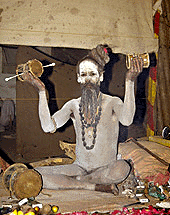
2136 Saraswati Giri is a real master at the damaru. He rattles two different-sized drums simultaneously, each at a different speed, creating a specific rhythm. It is an active form of meditation and performing it for any length of time requires great concentration and physical strength. |
One large and prominent Shaiva
sect consists of the 'warrior ascetics', or Nagas (the 'naked'), who have
existed since the prehistoric past.
Though sadhus in general can de characterized as
peace-loving, the Nagas used to be extremely militant, fighting with
rivalling sects, the Muslims and later even the British. They were
excellent fighters for they had no fear of death. Among the Nagas -- as this name would lead us to expect -- we still find many sadhus who walk about naked. In other respects as well they represent the ideal image of the sadhu as it was created thousands of years ago. |
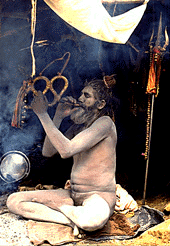
1185 High up in the icy Himalayas, but naked all the same, Bhola Giri Naga baba blows the serpentine horn, called nagphani, that is, 'cobra-hood', producing one piercing note. This instrument is related to the cobra (naga), the intimate companion of Lord Shiva, always coiled around his neck. |
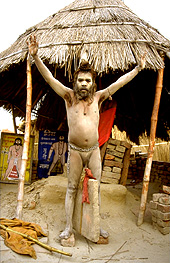 |
2339 Lal Baba keeps a special triangular stone for his lingasana (see below), on which is painted "30 kilos". He has developed this exercise into a regular show and even advertises himself as "lingasana Naga Baba" on painted boards (in the background). He is a small man so he has to stand on two bricks to lift the stone a few centimetres off the ground. But still, no mean feat: thirty kilos must be more than half his own weight. |
0255 Lifting weights with the penis, as done here by Shyam Puri, is in essence the same exercise as the chabi (see above). It is a 'miracle' that the penis is not torn off. The scene recalls the chains used in the past to weigh down the penis continuously, but this exercise is now only occasionally done, and then for a minute or so. Just long enough to show the sadhu's power, his transcendence of sexuality. |
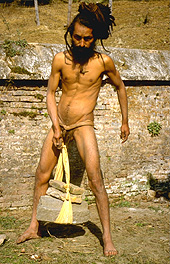 | |
Strangely enough, lifting weights with the penis does not have a special name, but is generally designated as a kriya (yogic exercise). Lal Baba (see above, photo 2339) uses the term lingasana (penis-posture), which he probably coined himself. In a sense it is reminiscent of the now historic kara-lingi, the ball-and-chain with which the penis was continuously weighed down. As Abbé Dubois, a French missionary who lived in India from 1792 to 1823, observed in his Hindu Manners, Customs and Ceremonies: "they attach to their generative organs a heavy weight which they drag about until the power of muscles and nerves is completely destroyed." So the aim of these exercises (lingasana and chabi) is certainly not to enlarge the penis, as some rumours would have it, but rather to desensitize the penis, to destroy its erectile capacity. Whether this aim is actually achieved is hard to say, but it is a fact that the dozens of sadhus that I have observed performing these exercises did not have a larger than normal penis. | ||||
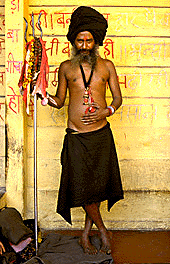 |
0153 Pagal Mauni Baba belongs to the Aghori section of the Gorakhnathis. As his name reveals, this Baba is 'mad, divinely intoxicated' (pagal) and 'non-speaking' (mauni). | The Gorakhnathis are
commonly referred to as Yogis or Jogis. Although in outlook very similar to the sannyasis, the Jogis do not follow the Vedantic teachings of Shankara, but adhere to the Tantric way taught by their Guru-founder Gorakhnath. Still, they are devotees of Shiva, albeit in his manifestation as Bhairava, and they worship Hanuman and Dattatreya. Gorakhnath, being an incarnation of Shiva, is worshipped as a deity by the Jogis, and has a number of temples dedicated to him. The Jogis are therefore often designated as 'Gorakhnathis', or more simply 'Nath-Babas'. |
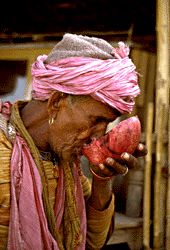
2389 Drinking out of a human skull is only one of the striking peculiarities that differentiates Gauri Shankar Mishra from the average ascetic. He drinks liquor (forbidden to caste Hindus and certainly ascetics), eats the flesh of dead animals found in the street and abuses people with foul obscenities. |
Holiness cannot only be macho,
but even 'crazy', god-possessed, as it is shown by the members of a rather
obscure and small sect, the Aghoris. They emulate the most extreme characteristics of Lord Shiva as the Conqueror of Death: his favourite haunt is the cremation-grounds; he bathes in cremation-ashes; he wears a garland of skulls and bones; he keeps spirits and ghosts for company; he is continuously intoxicated; and he acts like a madman. The Aghoris willingly transgress all ascetic (and Hindu) taboos, convinced as they are that by 'reversing all values' they will speed up enlightenment. While all sadhus are supposed to be vegetarian and teetotallers (like all ordinary Hindus for that matter), Aghoris eat meat and drink alcohol. Even more horrid habits are attributed to Aghoris: they eat the putrid flesh of corpses; they eat excrement and drink urine, even of a dog; they have ritual intercourse with menstruating prostitutes on the cremation-grounds, where they usually hang out; and they meditate while sitting on a corpse. It is questionable whether all this is regularly done, but it seems quite certain that at least occasionally, and then in a ritual context, as a kind of 'eucharist', these cannibalistic and other 'inhuman' acts are still taking place. Aghoris preferably live on cremationgrounds and
surround themselves with artifacts of death, like human skulls out of
which they drink and with which they perform magical
rituals. |
| In the beginning of the
fourteenth century, a very successful ascetic sect was founded by
Ramananda: the Ramananda Sampradaya, more popularly known as the
Ramanandis. Nowadays, because of its dominant position, it is regarded as a separate organization, but officially it is still part of the Shri Sampradaya, for Ramananda started his ascetic career as a member of this sect. He remained loyal to the philosophy of its founder Ramanuja, but he choose Rama and Sita as personal gods, and made devotion to them the central feature of the sect's religious practices. |
1877 Sects can be recognized by the symbols painted on the forehead, but within a sect the marks are seldom entirely identical. Most sadhus give it a personal touch. But some make more extreme variations on the fundamental theme. The result can be quite impressive, as is shown by Hanuman Hari Das, but it does not necessarily imply a higher status. Nor does it, by itself, reflect a higher degree of spirituality. |  |
| On the poster below Rama and
Sita are surrounded by the main characters of the Ramayana and the
Hindu pantheon. Kneeling before them is their faithful servant Hanuman, the monkey-god and general of the monkey army. The epic Ramayana, with its many exemplary adventures of Rama, is the primary source of inspiration for shaping the attitude of exclusive, one-pointed devotion to Rama which is the hallmark of a Rama devotee. | ||
Rama plays an important part in contemporary Hinduism. He lives in the hearts of the common people. He rules the lives of sadhus devoted to him. For many sadhus, memorizing, analyzing, and absorbing the Ramayana is a life-time pursuit, and some become professional exegetes, reciting and interpreting the texts to the public. |
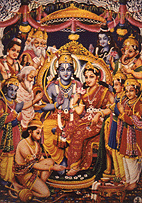 |
It is believed that just hearing the sacred words of the Ramayana is in itself liberating and will confer the grace of Rama. And in an even simpler way, continuous recitation of the name of Rama from the heart will enlighten the soul. In fact, in this Dark Age, Rama's devotees regard it as the only way to reach the Absolute. And if enligtenment does not happen in one’s life, it may happen at the moment of death, that is, if one dies thinking of Rama and with his name on one’s lips. As it is chanted by the mourners in funeral processions: “Rama nama satya hai!”, “the name of Rama is Truth.” |
| Celibacy is no doubt the
most important austerity practised by sadhus. According to
Yoga-metaphysics, sexual energy, the fire of passion, is the main
potential source of spiritual energy. But as an aid to mental control of sexuality, physical restraint must sometimes be employed and one method is the continuous wearing of 'chastity belts'. | |||
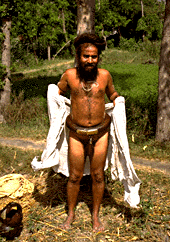 |
1076 This wooden arbandh with
its wooden langoti attached, may quite rightly be called a
'chastity-belt'; only this one is self-imposed. The langoti can be unhooked for cleaning, but the arbandh of course stays on all the time. Jaganath Das has worn the belt for thirteen years and has vowed to remain doing so for life. This austerity, like most, is usually undertaken for a minimum of twelve years. A dhoti usually, modestly, covers this wooden underwear, but as these Bab's are about to take a bath, they have a valid reason to take it off. |
1074 Kailas Das
has worn this steel chastity-belt for fifty years. He is also known as Mauni Baba, for he did not speak for twelve years. |
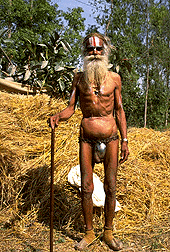 |
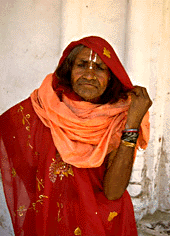
1943 A sakhi, who regards Lord Rama as her Lover. |
Sadhus who have chosen Rama or
Krishna as their deity, are characterized by a strong, sentimental
devotion and total self-surrender to one of his earthly 'incarnations' as
the god-king Rama or the divine cowherd Krishna. The deity is regarded as a 'person' with whom the devotee can establish an intimate bond, which usually takes the form of a Master-slave relationship. Some sadhus, however, dare to regard him as their Lover, and since the deity is a male, it follows quite logically that they have to play the part of 'mistress' of the Lord. They are designated as sakhis. They imagine having an erotic 'love' relationship with him. Some sakhis even go to the extreme of pretending to have regular sexual intercourse with their Lord -- except on the days when they're having their 'period'. Obviously, the sexual overtones of their behaviour
make them rather suspect in the eyes of other ascetics, since repression
of sexuality is the norm, not its projection. Even if this projection is
aimed at a deity. |
These transvestite sadhus are to be distinguished from another group of transvestites, or rather eunuchs, who practise prostitution and obnoxious forms of begging. The hijras, as they are known, are completely castrated upon initiation into their order. They are regarded as 'neither man nor woman', but they dress like women and affect exaggerated female mannerisms. As in almost all things Indian, there is a religious meaning to their voluntary mutilation and subsequent behaviour. During Rama-festivals hijras may masquerade as sakhis in order to collect more money. | |
| Every foreigner in India, no
matter how long he stays and how completely he 'Indianizes', will always
remain an alien. Yet foreigners can become sadhus too, and the locals consider them just as holy as Indian sadhus. Especially the simple rustics (75% of the total population still lives in the countryside) treat them with great respect and ask for their blessing. The city-dwellers, the modern, Westernized Indians often show less understanding. Though many nationalities are represented, and both male and female, most of these foreigners are Italian or French. | |||
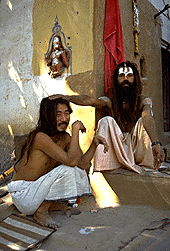 |
1590 Mohan Das (left), a Japanese sadhu, being blessed by his guru of two years, Mathura Das. According to ancient tradition, the pupil must carry out all his teacher's chores, and Mohan Das acts almost as the slave of his master. However, he does so willingly, since such work brings much positive "karma" to wipe away the sins of previous lives. |
1957 Charan Das, originally an American, has lived as a sadhu in India for over twenty years. Cheerful and without cares, he roams the country for part of the year, going from one holy place to the other, visiting with brother-sadhus. The other part of the year he spends in his guru's ashram; a period of study. |
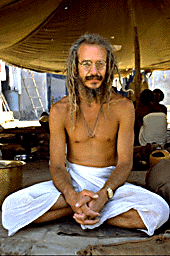 |
Some foreign sadhus are 'part-timers', who time and again plunge into the adventure of sadhu-life but keep their ties to the home-front. Others burn all their bridges, as it should be done, and totally commit themselves to the realization of the sadhu ideals. | |||